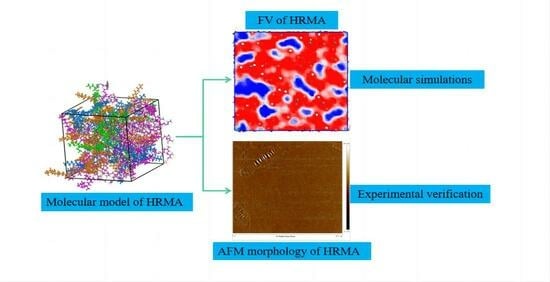Molecular Interaction Mechanism between Aromatic Oil and High-Content Waste-Rubber-Modified Asphalt
Abstract
:1. Introduction
2. Materials and Methods
2.1. Raw Materials
2.2. Molecular Simulations of HRMA
2.2.1. Molecule Building
2.2.2. Simulation Details
2.2.3. The Calculation of Radial Distribution Function
2.2.4. The Calculation of Diffusion Coefficient
2.2.5. The Calculation of Free Volume
2.2.6. The Calculation of Solubility Parameter
2.2.7. The Calculation of Shear Viscosity
2.2.8. The Calculation of Rubber Dispersion
2.3. Experimental Verification
2.3.1. Storage Stability Test of HRMA
2.3.2. Adhesive Force Test of HRMA
2.3.3. The Functional Group Test of HRMA
3. Results and Discussion
3.1. Molecular Interaction Analysis of HRMA
3.2. Viscosity Reduction Mechanism Analysis of HRMA
4. Conclusions and Suggestions for Future Studies
Author Contributions
Funding
Institutional Review Board Statement
Informed Consent Statement
Data Availability Statement
Acknowledgments
Conflicts of Interest
References
- Modupe, A.E.; Atoyebi, O.D.; Oluwatuyi, O.E.; Aladegboye, O.J.; Busari, A.A.; Basorun, A.O. Dataset of mechanical, marshall and rheological properties of crumb rubber-Bio-oil modified hot mix asphalt for sustainable pavement works. Data Brief 2018, 21, 63–70. [Google Scholar] [CrossRef] [PubMed]
- Cao, L.; Su, Z.; Liu, R.; Zhou, T. Optimized formulation of asphalt compound containing bio-oil and shredded rubber. J. Clean. Prod. 2022, 378, 134591. [Google Scholar] [CrossRef]
- Qiu, Y.; Gao, Y.; Zhang, X.; Wei, Y.; Cao, J.; Wang, X.; Wang, S. Conventional properties, rheological properties, and storage stability of crumb rubber modified asphalt with WCO and ABS. Constr. Build. Mater. 2023, 392, 131987. [Google Scholar] [CrossRef]
- Duan, K.; Wang, C.; Liu, J.; Song, L.; Chen, Q.; Chen, Y. Research progress and performance evaluation of crumb-rubber-modified asphalts and their mixtures. Constr. Build. Mater. 2022, 361, 129687. [Google Scholar] [CrossRef]
- Zhao, M.; Dong, R. Reaction mechanism and rheological properties of waste cooking oil pre-desulfurized crumb tire rubber/SBS composite modified asphalt. Constr. Build. Mater. 2021, 274, 122083. [Google Scholar] [CrossRef]
- Wu, W.; Jiang, W.; Xiao, J.; Yuan, D.; Wang, T.; Xing, C. Analysis of thermal susceptibility and rheological properties of asphalt binder modified with microwave activated crumb rubber. J. Clean. Prod. 2022, 377, 134488. [Google Scholar] [CrossRef]
- Yang, H.; Dong, R. Investigating the properties of rejuvenated asphalt with the modified rejuvenator prepared by waste cooking oil and waste tire crumb rubber. Constr. Build. Mater. 2022, 315, 125692. [Google Scholar] [CrossRef]
- Wang, S.; Cheng, D.; Xiao, F. Recent developments in the application of chemical approaches to rubberized asphalt. Constr. Build. Mater. 2017, 131, 101–113. [Google Scholar] [CrossRef]
- Liu, Q.; Han, B.; Wang, S.; Falchetto, A.C.; Wang, D.; Yu, B.; Zhang, J. Evaluation and molecular interaction of asphalt modified by rubber particles and used engine oil. J. Clean. Prod. 2022, 375, 134222. [Google Scholar] [CrossRef]
- Kabirb, S.F.; Zakertabrizi, M.; Hosseini, E.; Fini, E.H. Effects of Amide-Based modifiers on surface activation and devulcanization of rubber. Comput. Mater. Sci. 2021, 188, 110175. [Google Scholar] [CrossRef]
- Yan, Y.; Guo, R.; Liu, Z.; Yang, Y.; Wang, X.Y. Property improvement of thermosetting natural rubber asphalt binder by mineral oil. J. Mater. Res. Technol. 2023, 24, 8807–8825. [Google Scholar] [CrossRef]
- Feng, X.; Liang, H.; Dai, Z. Rheological properties and microscopic mechanism of waste cooking oil activated waste crumb rubber modified asphalt. J. Road Eng. 2022, 2, 357–368. [Google Scholar] [CrossRef]
- Ma, J.; Hu, M.; Sun, D.; Lu, T.; Sun, G.; Ling, S.; Xu, L. Understanding the role of waste cooking oil residue during the preparation of rubber asphalt. Resour. Conserv. Recycl. 2021, 167, 105235. [Google Scholar] [CrossRef]
- Wang, H.; Jing, Y.; Zhang, J.; Cao, Y.; Lyu, L. Preparation and performance evaluation of swine manure bio-oil modified rubber asphalt binder. Constr. Build. Mater. 2021, 294, 123584. [Google Scholar] [CrossRef]
- Lei, Y.; Wei, Z.; Wang, H.; You, Z.; Yang, X.; Chen, Y. Effect of crumb rubber size on the performance of rubberized asphalt with bio-oil pretreatment. Constr. Build. Mater. 2021, 285, 122864. [Google Scholar] [CrossRef]
- Lyu, L.; Pei, J.; Hu, D.; Sun, G.; Fini, E.H. Bio-modified rubberized asphalt binder: A clean, sustainable approach to recycle rubber into construction. J. Clean. Prod. 2022, 345, 131151. [Google Scholar] [CrossRef]
- Kumar, A.; Choudhary, R.; Kumar, A. Composite asphalt binder modification with waste Non-tire automotive rubber and pyrolytic oil. Mater. Today Proc. 2022, 61, 158–166. [Google Scholar] [CrossRef]
- Zhou, T.; Kabir, S.F.; Cao, L.; Luan, H.; Dong, Z.; Fini, E.H. Comparing effects of physisorption and chemisorption of bio-oil onto rubber particles in asphalt. J. Clean. Prod. 2020, 273, 123112. [Google Scholar] [CrossRef]
- Lyu, L.; Mikhailenko, P.; Piao, Z.; Fini, E.H.; Pei, J.; Poulikakos, L.D. Unraveling the modifcation mechanisms of waste bio-oils and crumb rubber on asphalt binder based on microscopy and chemo-rheology. Resour. Conserv. Recycl. 2022, 185, 106447. [Google Scholar] [CrossRef]
- Li, D.D.; Greenfield, M.L. Chemical compositions of improved model asphalt systems for molecular simulations. Fuel 2014, 115, 347–356. [Google Scholar] [CrossRef]
- Zhou, X. Physicochemical properties of high-content rubber modified bio-asphalt using molecular simulation. Pet. Sci. Technol. 2023, 9, 2210601. [Google Scholar] [CrossRef]
- Ren, S.; Liu, X.; Gao, Y.; Jing, R.; Lin, P.; Erkens, S.; Wang, H. Molecular dynamics simulation and experimental validation on the interfacial diffusion behaviors of rejuvenators in aged bitumen. Mater. Des. 2023, 226, 111619. [Google Scholar] [CrossRef]
- Ren, S.; Liu, X.; Lin, P.; Erkens, S.; Gao, Y. Chemical characterizations and molecular dynamics simulations on different rejuvenators for aged bitumen recycling. Fuel 2022, 324, 124550. [Google Scholar] [CrossRef]
- Zhou, X.; Zhao, G.; Miljković, M.; Tighe, S.; Chen, M.; Wu, S. Crystallization kinetics and morphology of biochar modified bio-asphalt binder. J. Clean. Prod. 2022, 349, 131495. [Google Scholar] [CrossRef]
- Eltwati, A.; Al-Saffar, Z.; Mohamed, A.; Hainin, M.R.; Elnihum, A.; Enieb, M. Synergistic effect of SBS copolymers and aromatic oil on the characteristics of asphalt binders and mixtures containing reclaimed asphalt pavement. Constr. Build. Mater. 2022, 327, 127026. [Google Scholar] [CrossRef]
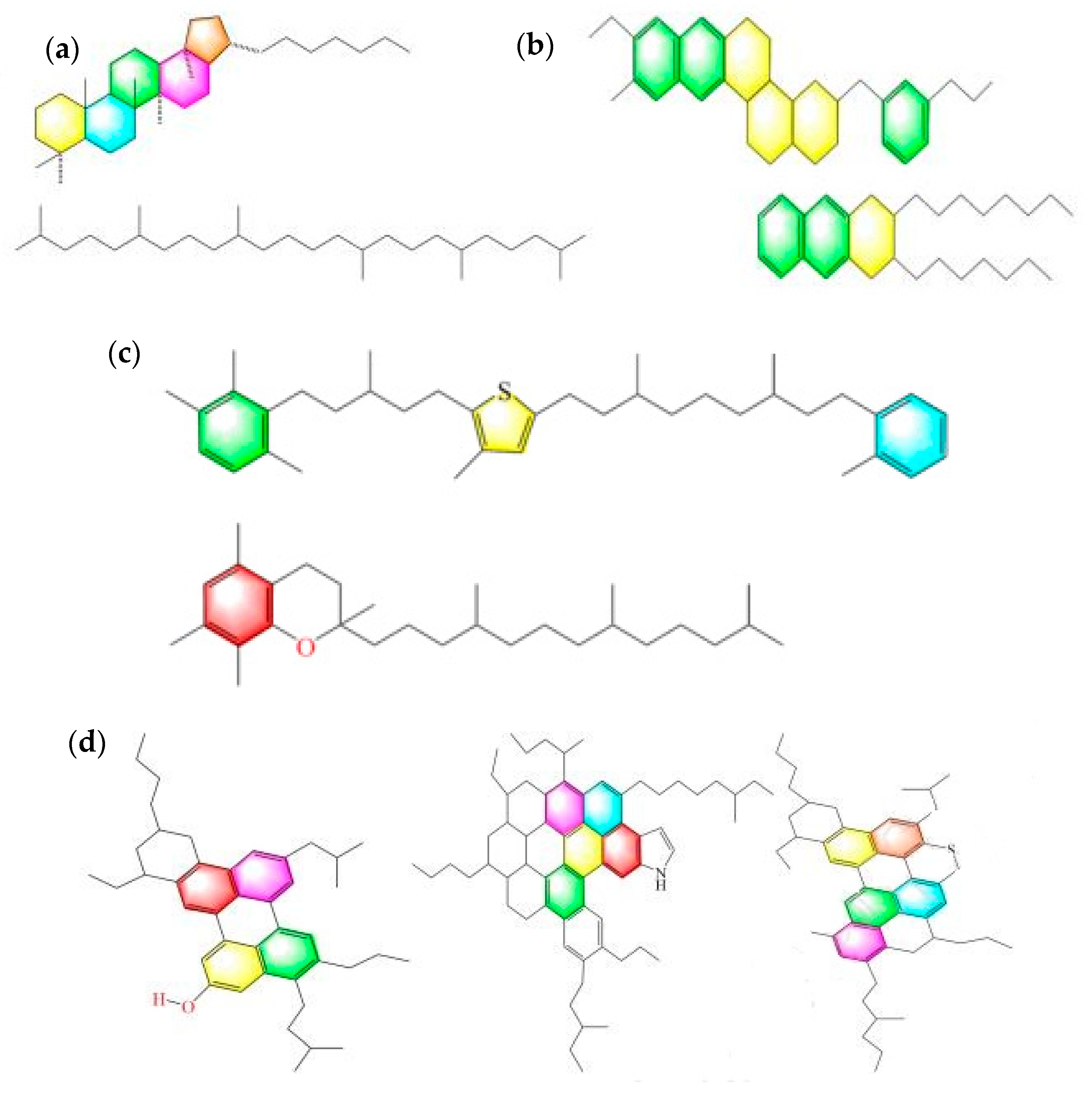

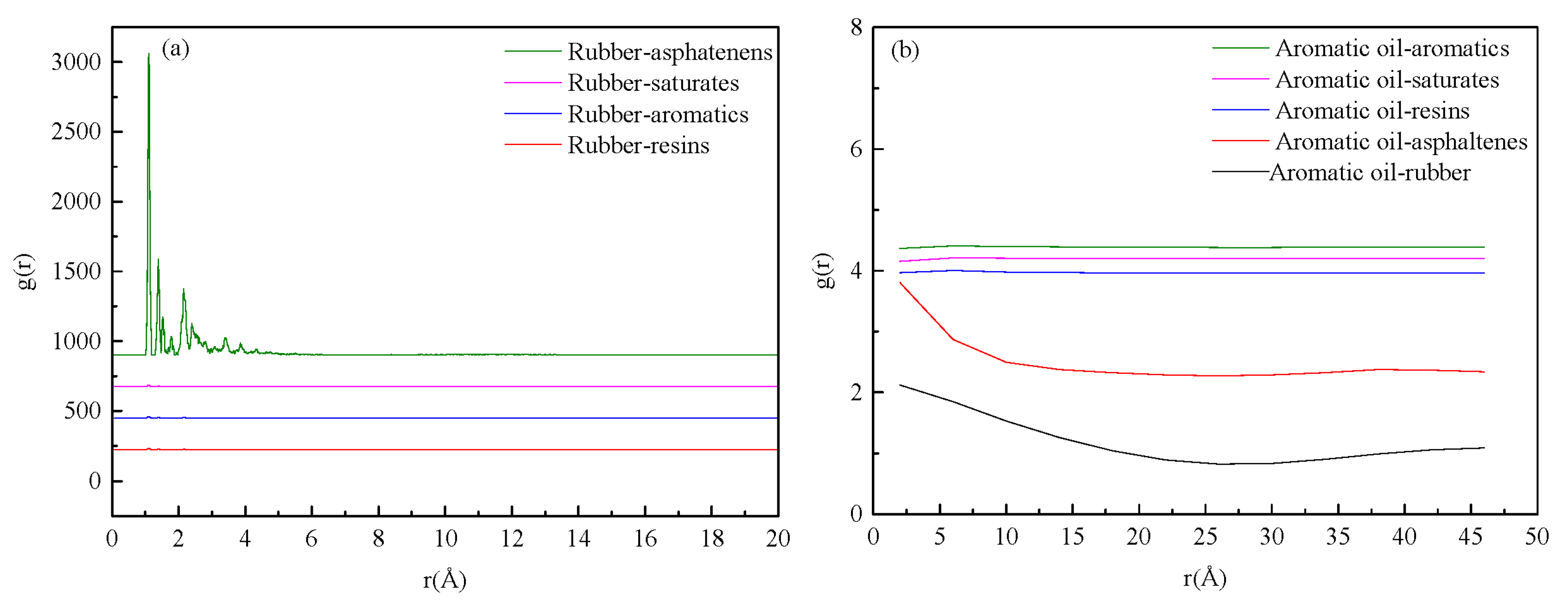
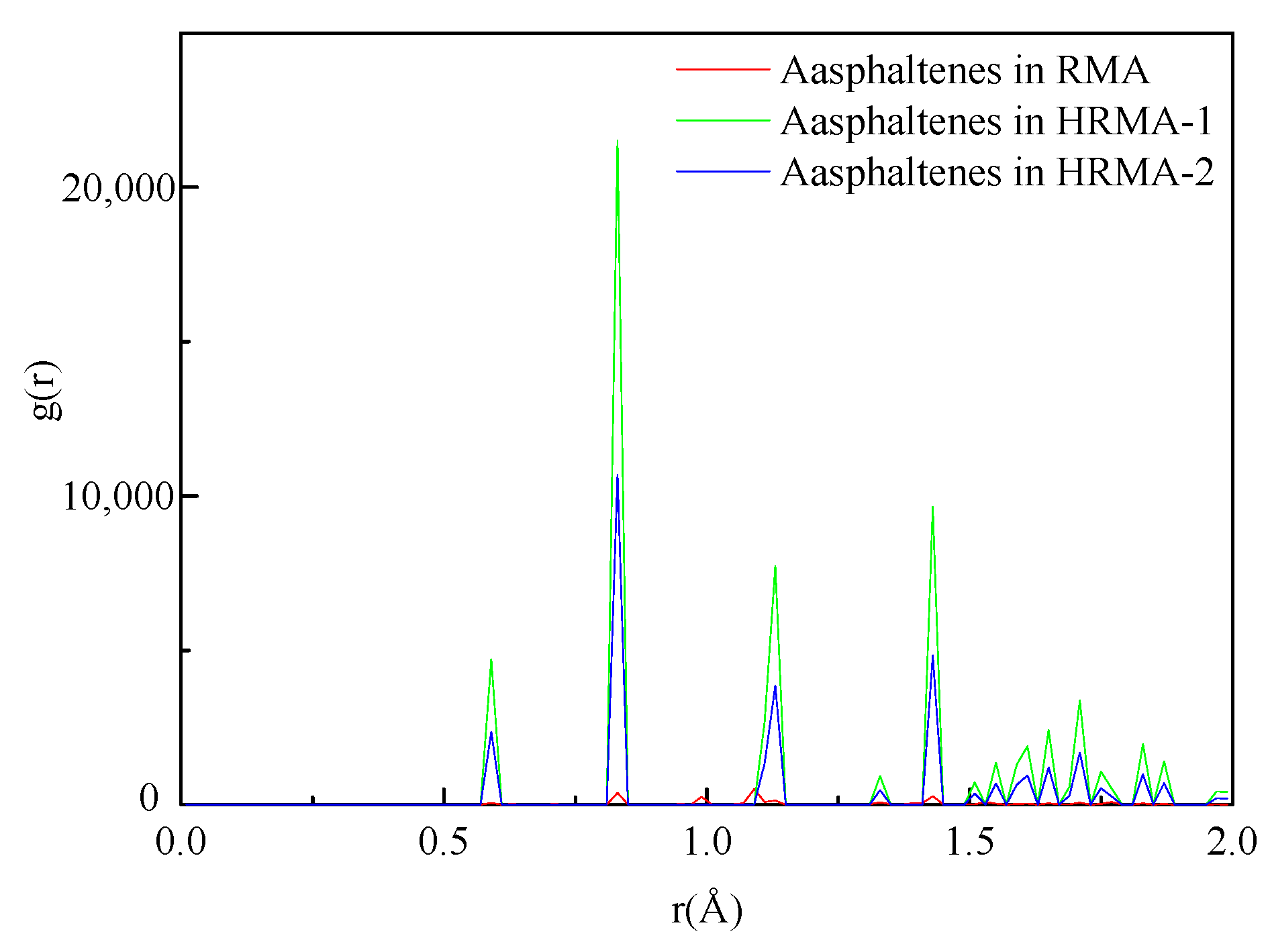
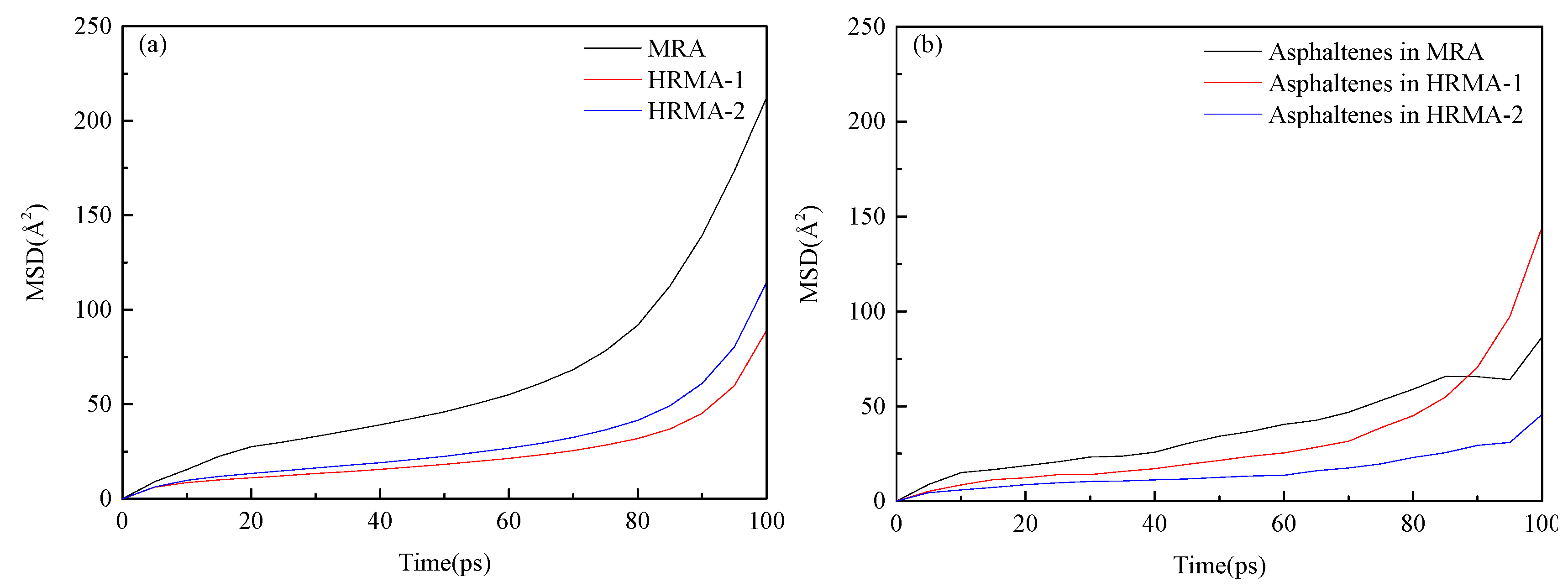

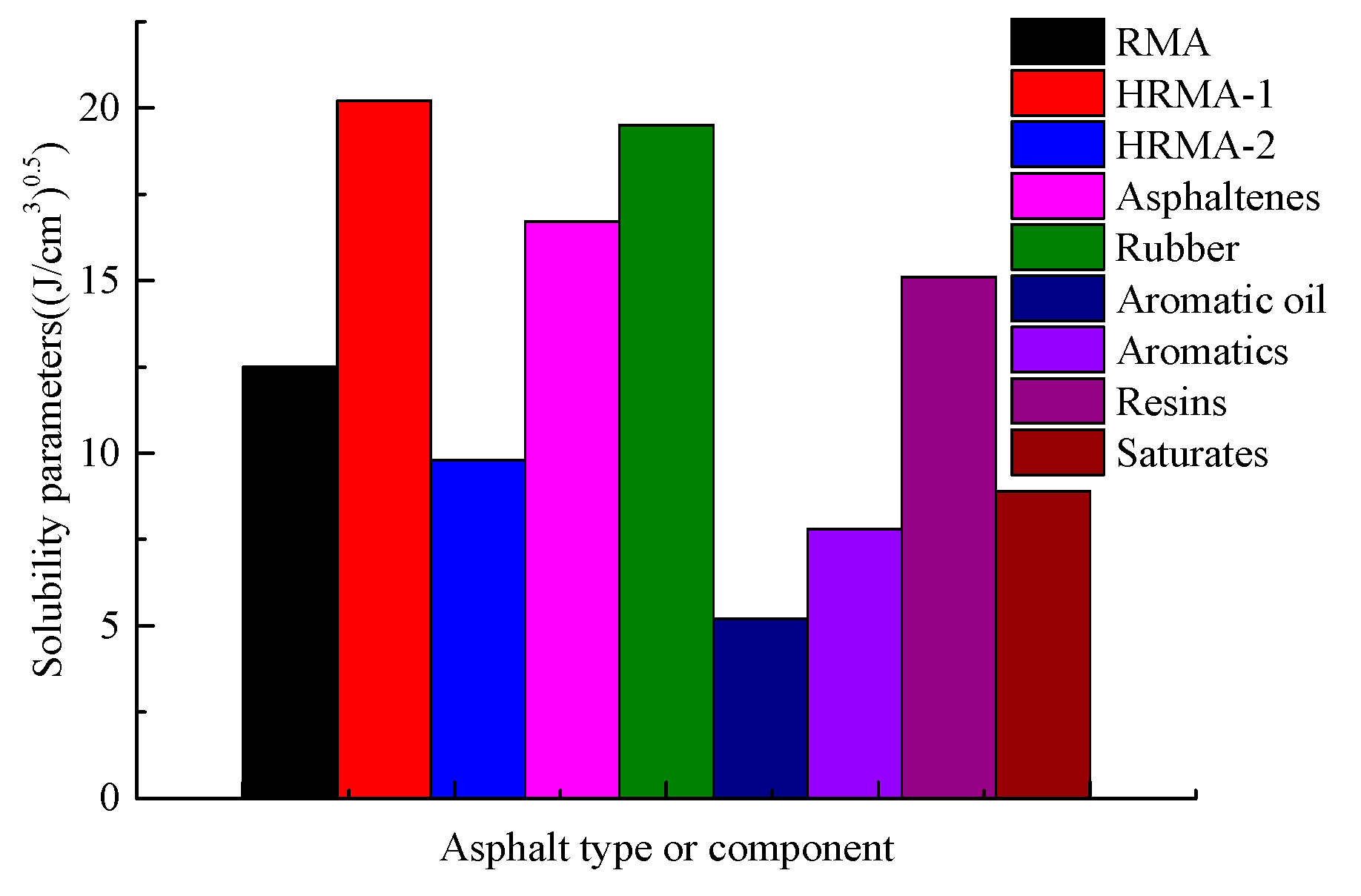

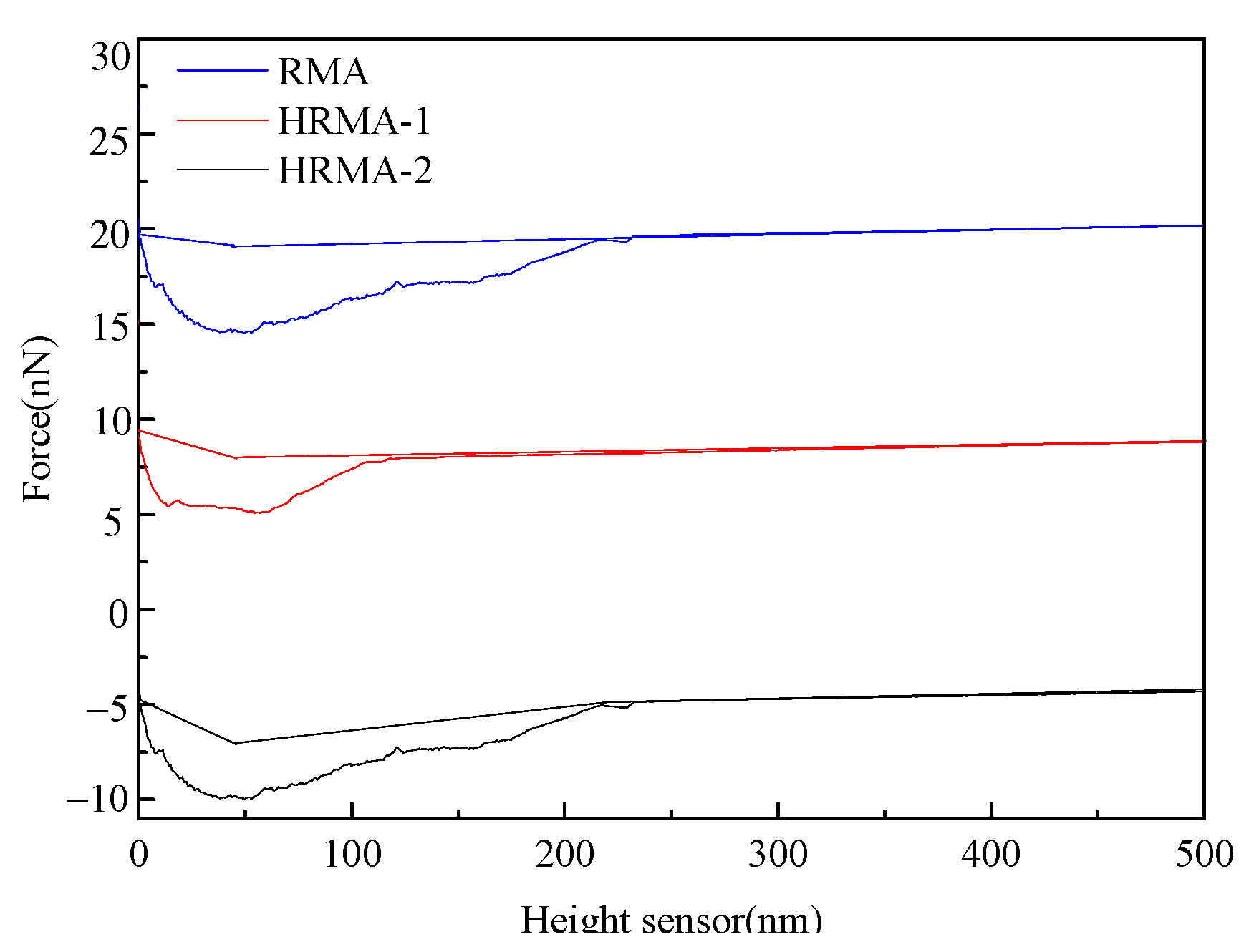
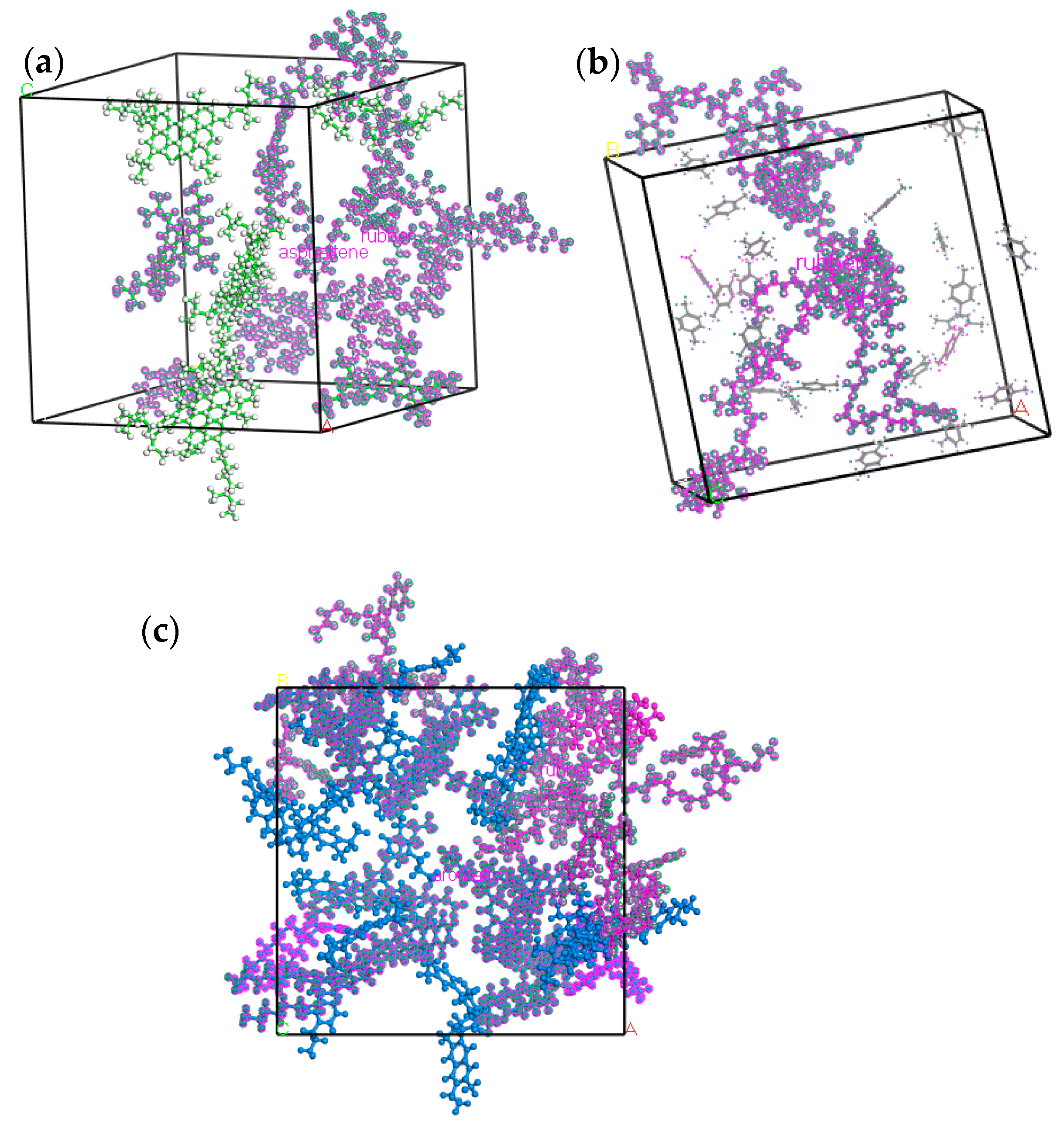
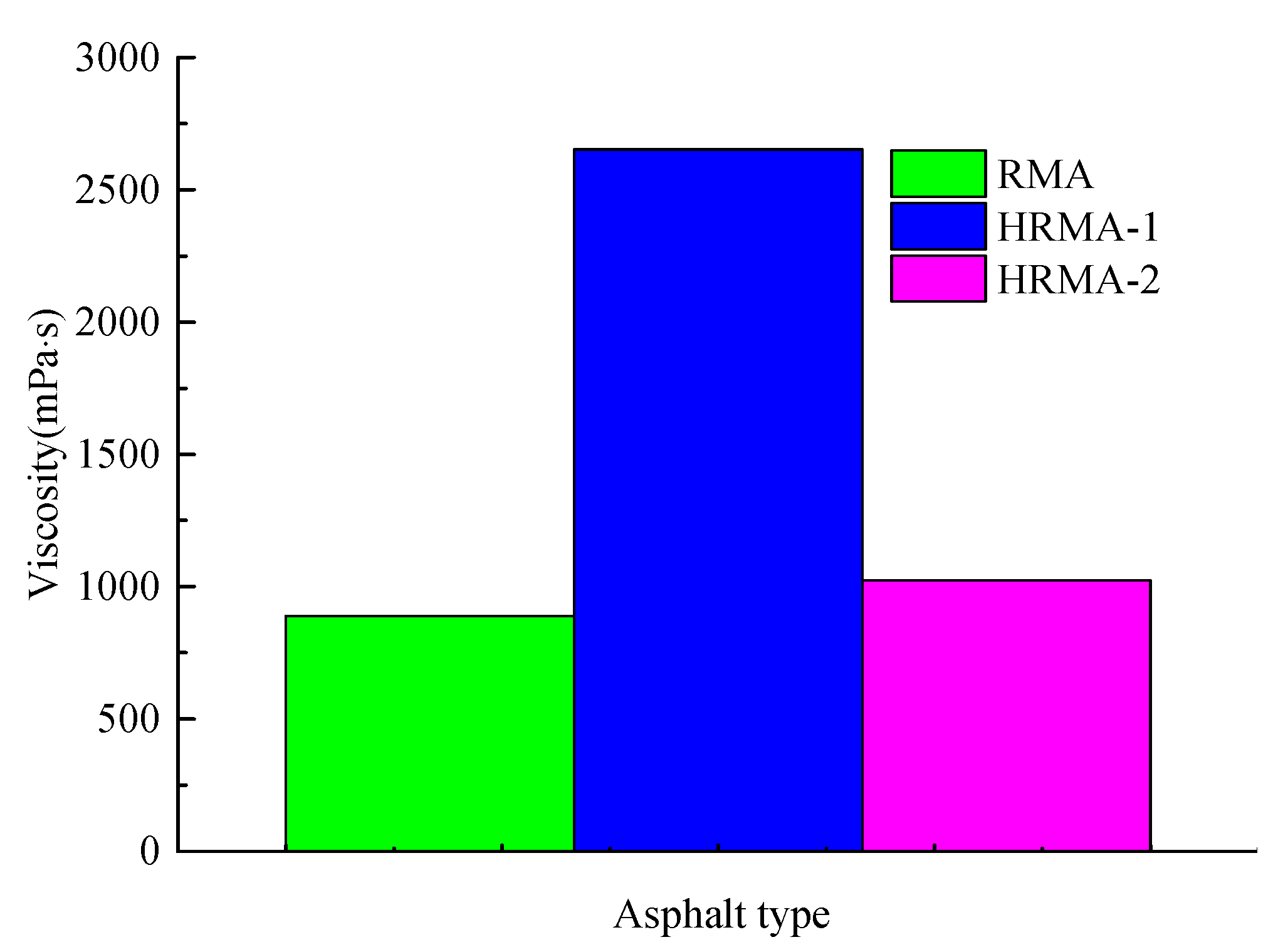
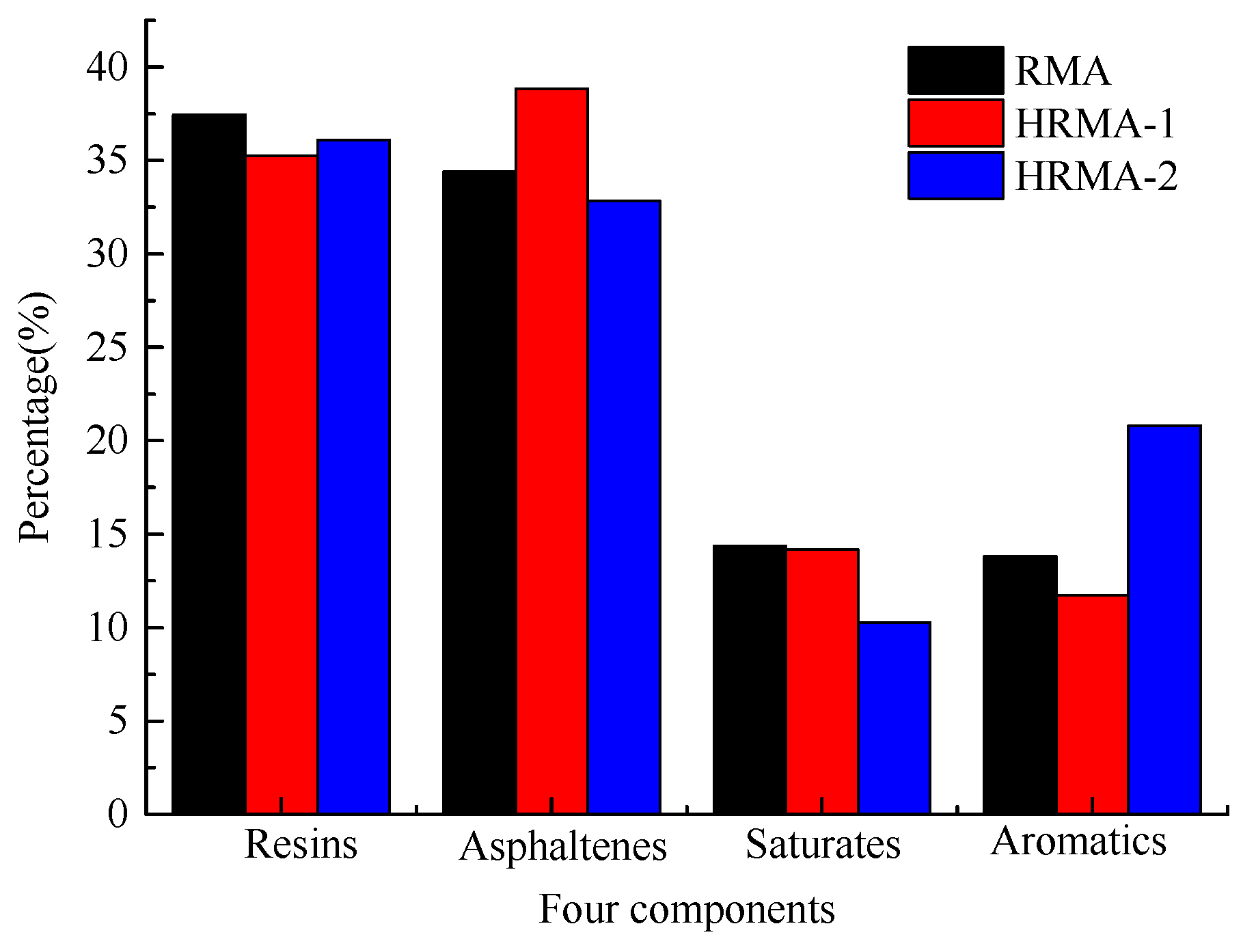


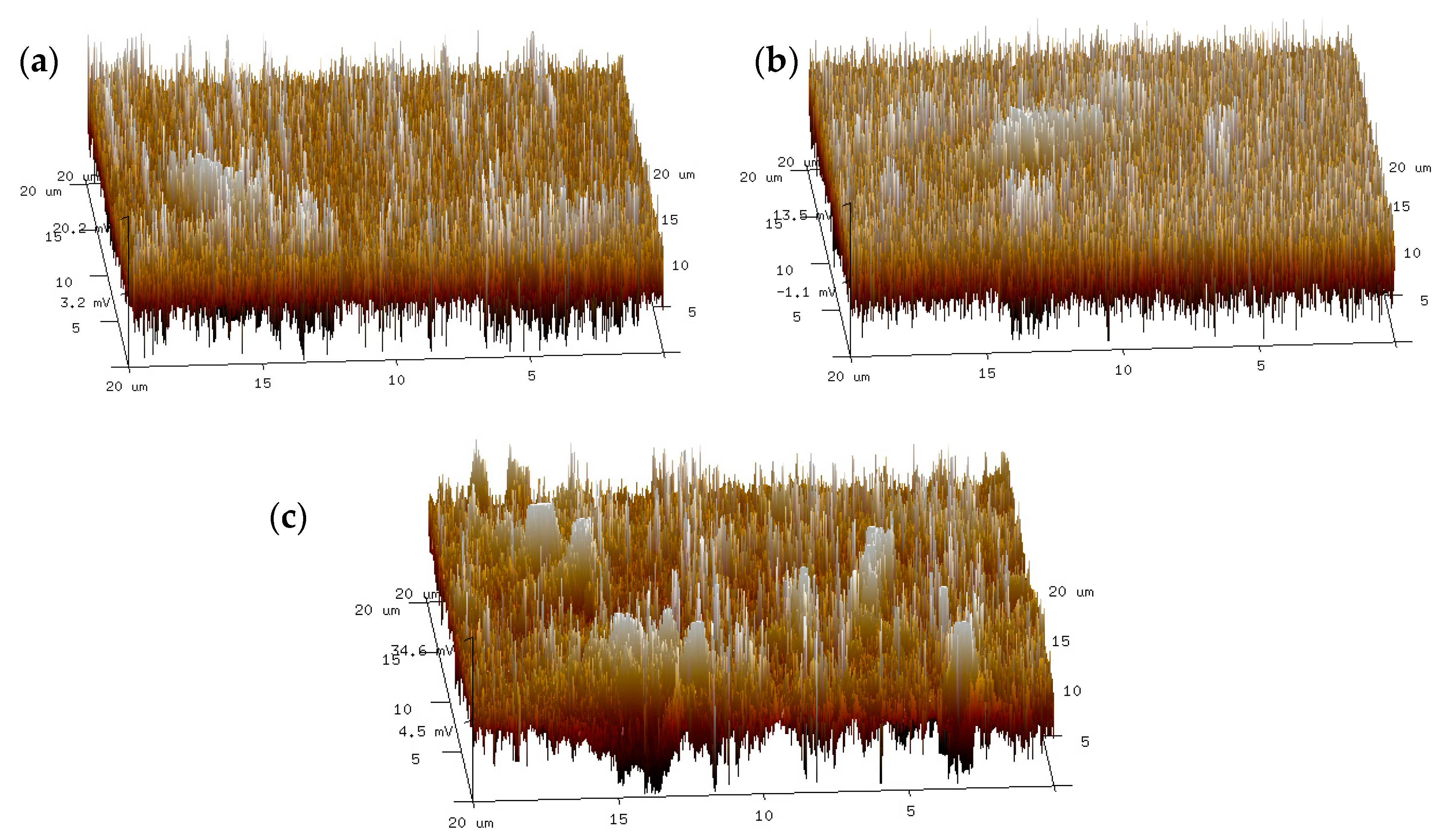
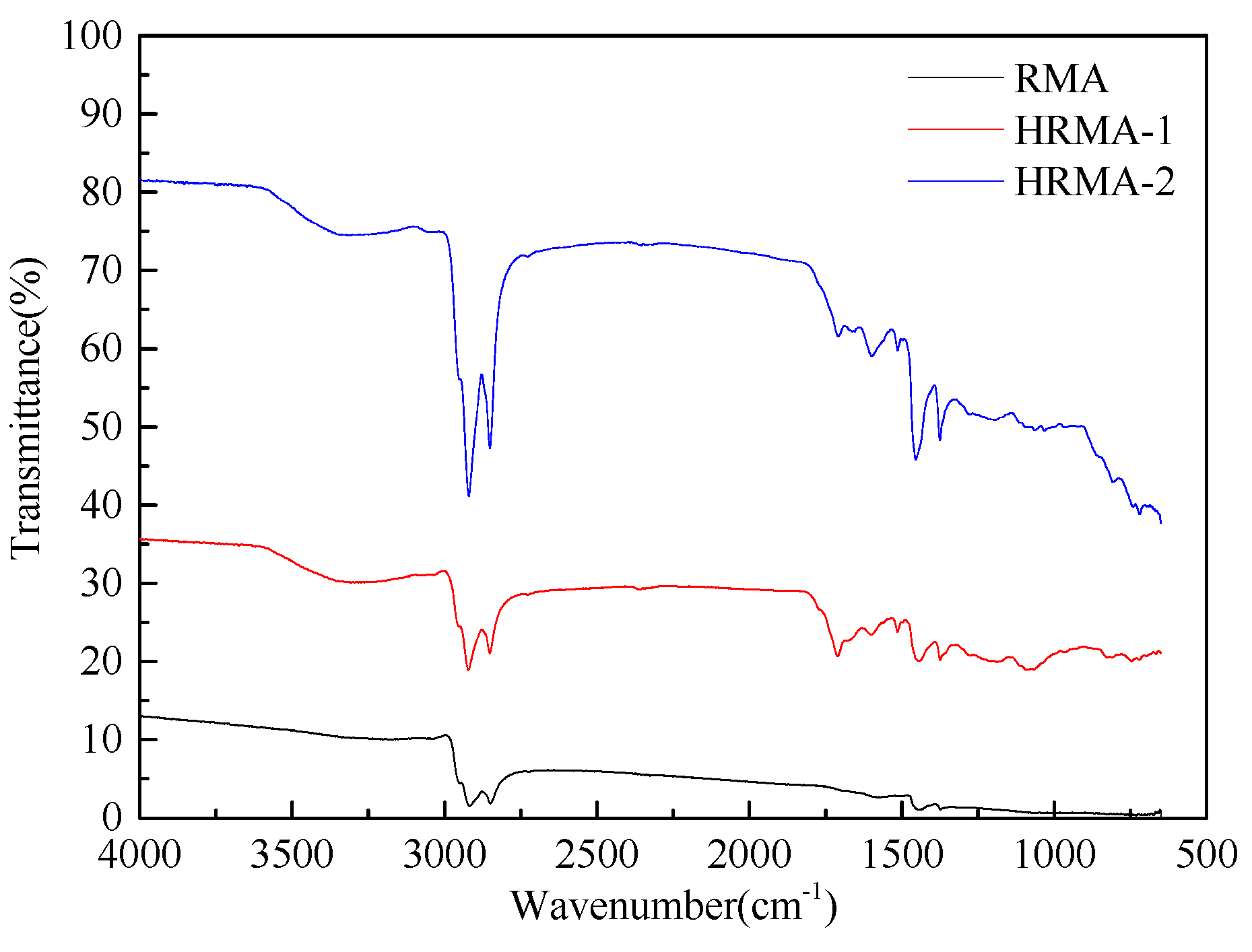
| Material | Penetration (25 °C, 0.1 mm) | Penetration Index (PI) | Softening Point (°C) | Ductility (5 °C, cm) |
|---|---|---|---|---|
| Asphalt | 64 | 0.90 | 49 | 21 |
| HRMA | 52 | 0.85 | 62 | 35 |
| Density (g/cm3) | Flash point (°C) | Kinematic viscosity (mm2/s) | Condensation point (°C) | |
| Aromatic oil | 1.02 | 218 | 17 | −5 |
| Specific gravity | Moisture content (%) | Sieving rate (40 mesh, %) | Ash content (%) | |
| Waste rubber | 1.13 | <1.0 | ≥95 | ≤1.0 |
| Asphalt | Molecular Formula | Number of Molecules | Mass Fraction (%) |
|---|---|---|---|
| Resins | C18H10S2 | 15 | 37.44 |
| C29H50O | 5 | ||
| Asphaltenes | C66H81N | 2 | 34.39 |
| C51H62S | 3 | ||
| C42H54O | 3 | ||
| Saturates | C35H62 | 4 | 14.36 |
| C30H62 | 4 | ||
| Aromatic | C30H46 | 13 | 13.81 |
| C35H44 | 11 | ||
| Rubber | C88H86 | 3/4 | |
| Aromatic oil | C8H10 | 22 |
| Asphalt | D (10−7 cm2/s) | Component | D (10−7 cm2/s) |
|---|---|---|---|
| RMA | 2.58 | Aromatic oil | 3.25 |
| HRMA−1 | 1.82 | Rubber | 1.12 |
| HRMA−2 | 2.45 | Aromatics | 2.89 |
| Resins | 2.52 | ||
| Saturates | 2.35 | ||
| Asphaltenes | 1.58 |
Disclaimer/Publisher’s Note: The statements, opinions and data contained in all publications are solely those of the individual author(s) and contributor(s) and not of MDPI and/or the editor(s). MDPI and/or the editor(s) disclaim responsibility for any injury to people or property resulting from any ideas, methods, instructions or products referred to in the content. |
© 2023 by the authors. Licensee MDPI, Basel, Switzerland. This article is an open access article distributed under the terms and conditions of the Creative Commons Attribution (CC BY) license (https://creativecommons.org/licenses/by/4.0/).
Share and Cite
Yan, Y.; Zhou, X.; Jiang, R.; Ran, M.; Zhou, X. Molecular Interaction Mechanism between Aromatic Oil and High-Content Waste-Rubber-Modified Asphalt. Sustainability 2023, 15, 14079. https://doi.org/10.3390/su151914079
Yan Y, Zhou X, Jiang R, Ran M, Zhou X. Molecular Interaction Mechanism between Aromatic Oil and High-Content Waste-Rubber-Modified Asphalt. Sustainability. 2023; 15(19):14079. https://doi.org/10.3390/su151914079
Chicago/Turabian StyleYan, Yuan, Xinxing Zhou, Ruiqie Jiang, Maoping Ran, and Xinglin Zhou. 2023. "Molecular Interaction Mechanism between Aromatic Oil and High-Content Waste-Rubber-Modified Asphalt" Sustainability 15, no. 19: 14079. https://doi.org/10.3390/su151914079




